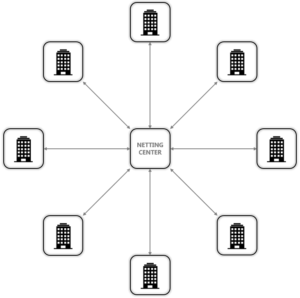The principles of multilateral netting: what, why and how
| 27-06-2019 | ENIGMA Consulting |
This article is meant as an introduction to the process of multilateral netting for international companies. It describes the fundamental concept of netting, the steps within the netting process and the ultimate benefits of netting. In addition, we elaborate upon the role of technology in netting and prepared a checklist for anyone that considers using netting in their company.
1. What is (multilateral) netting?
Netting is the process of consolidating payables against receivables between parties. Rather than settling each individual invoice leading to a large volumes of transactions, parties can consolidate invoices and agree upon one net payment stream. In the majority of the cases, netting is set up between internal group entities as parties for settling their intercompany invoices, but external (third) parties could participate in a netting process as well.
Most of the netting methodologies are either payables- or receivables-driven. In a payables-driven system, payables are netted against the payables of the other participants and in a receivables-driven system, receivables are used. Note that in the end it is (or should be) a zero sum game: intercompany receivables = intercompany payables.
If there are only two parties involved in the netting process it is called bilateral netting. If there are more than two parties involved that use a central entity to interact for all their intercompany transactions then the process is called multilateral netting. The figures below illustrate the differences between the payment flows before and after implementing a multilateral netting solution using a central entity (netting center).
Intercompany process without multilateral netting Intercompany process with multilateral netting
2. How does the multilateral netting process works?
In general, the netting process (netting cycle) involves the steps outlined below:
Step 1: Collect invoice details from local entities
The first step is to have the local subsidiaries send their invoices to the netting center. Usually there is a central database where all the received invoices are collected. See also chapter 4 on technology.
Step 2: Verify / dispute invoices in the netting cycle
When invoices between two parties do not (automatically) match they should be investigated and disputes should be managed.
Step 3: Communicate netting balances to local entities
Once all invoices are reconciled, the netting center will calculate and send a netting statement to each of the local entities containing the balance that they will receive or need to pay.
Step 4: Settlement via cash or intercompany booking
The netting center distributes payments to the local entities that have positive balances. Local entities with negative balances will have to make a payment to the netting center. After the netting cycle is closed, a new round of collecting invoices will start (step 1).
3. Why use multilateral netting?
There are numerous advantages to those corporates that deploy multilateral netting:
- Reducing bank and transaction costs as a result of less funding transactions, less FX accounts and trades and savings on FX spreads, volumes and commissions. The pricing of FX deals can improve as the total number of FX transactions is consolidated into larger trades.
- Centralizing FX management as the netting center has the complete overview of currency requirements and is better able to hedge FX exposure.
- Standardizing the intercompany settlement process, creating both a single transparent approach throughout the company and discipline with regard to intercompany procedures and dispute management. This, in turn, can also minimize operational risks while maximize the operational efficiency.
- Improving the posting of intercompany invoices and reconciliation. By automizing this process (see chapter 4 on technology) not only treasury but also the accounting department benefits from netting.
For those international companies treating multilateral netting as part of their treasury roadmap it is possible to further enhance the benefits of netting by linking it with cash management. Integrating the use of a netting center with an in-house bank (IHB) can eliminate the use of physical cash payments by settling the net balances via the IHB.
So, for which companies it is worthwhile to consider multilateral netting? Corporates that have various (decentralized) local entities and various currencies and that have continuous multiple intercompany transactions between the local entities.
4. How can technology help
Technology and systems are key for an efficient and automated netting process. Examples of this are the following:
- Data collection
The netting center relies on external input from its participants in order to reconcile invoices and calculate final settlements. The A/P and A/R invoices should therefore be collected from the ERP system and be sent to the netting center each netting period. Automation of the data collection will help the consistency and reliability of the data input for the netting process - Netting calculation
For the netting calculation, systems are crucial as the calculation for multiple invoices from multiple parties, in multiple FX can be quite complex. - Dispute management
Where invoices are sent, disputes can occur. These disputes can originate from administrative issues or be business-oriented. In a complex environment with multiple transactions occurring daily, disputes can often be overlooked. Systems are a helpful tool in providing an internal dispute management system. - Liquidity management and settlement
Upon the completion of a netting run and all invoices being reconciled, each company will receive a final netting statement, containing their new balance to be paid to or received from the netting centre. When a subsidiary is due to owe money to the netting centre, they will have various settlement possibilities available for use, and systems play an inevitable role to support these settlements. Subsidiaries can settle via bank account wires, take internal loans from the group treasury or book via intercompany accounts. Systems can be used to streamline the settlement process. - Audit trail
Some systems can provide a fully audit trail on all key variables in the netting process. - Transparency and less manual tasks
When all stakeholders of the netting process are using one central system where everybody has access to, there is only ‘one source of truth’ that increases transparency and supports consistent involvement of all parties. Systems will also diminish the manual tasks in the process and decrease the vulnerability to errors.
Which system is used for the netting process depends very much on the system landscape of the company. Roughly there are three options:
- ERP system
As the source of the A/R and A/P is the ERP, it makes a lot of sense to use the ERP for the netting process as well. In the following situations the ERP system is not ideal option:
– when the company has multiple ERP systems
– when the ERP system lacks netting functionality
– when treasury has limited access to the ERP for the (internal or physical) settlement of the transactions - Treasury Management System (TMS)
Many TMS providers can deliver netting functionality that support the full netting cycle. Preferably the netting process is then set up with automatic upload/download interfaces for the input and output data from/to the ERP system(s). It requires that the treasury department takes the lead in the set up and management of the netting process. - Dedicated netting software
There is variety of other dedicated netting systems available where the netting process can take place. Interfacing with the TMS and the ERP is then even more important. Some companies also use Excel spread sheets for their netting process and that can still be practical solution if there are only limited parties involved, few internal invoices and a small number of currencies.
5. Checklist
To prepare the business case for setting up a netting process that meets the specific requirements of the organization, the checklist of questions below can be used.
| Checklist | |
| 1. | How many currencies are used for internal invoices? |
| 2. | What is the number of local entities? |
| 3. | What is the total amount of internal invoices per month, what is the monthly value and who are the counterparties of these invoices? |
| 4. | What is the background of the internal invoices: trade, interest, royalties, dividend, hedge contracts internal, fees, loan repayments, investments etc.? |
| 5. | In what countries are internal invoices send/received? |
| 6. | Which exchange control regulations are existing for cross border transfers and what are the fiscal and legal consequences of netting intercompany transactions? |
| 7. | How does the system landscape looks like, where is data stored and in which system(s) will the netting process takes place? |
| 8. | Where does FX management take place within the organization and how will that be impacted by the set-up of a netting process? |
| 9. | To assess the options for settlement of internal invoices: – How does the current bank (accounts) landscape looks like? – Is there already an in-house bank (IHB) structure set up? |
| 10. | What are the organizational consequences with respect to the treasury department, accounting processes and corporate policies? |
| 11. | Are there adequate resources available in the organization at the relevant departments (such as accounting, IT and treasury) to set up the netting process? |
Dominic Hoogendijk and Bas Kolenburg are experienced senior treasury consultants working for Enigma Consulting. Enigma Consulting is a trusted advisor in Payments, Risk & Compliance and Treasury with over 20 years of experience. Enigma Consulting serves all Dutch financial institutions, many (international) corporates and charity organizations.





